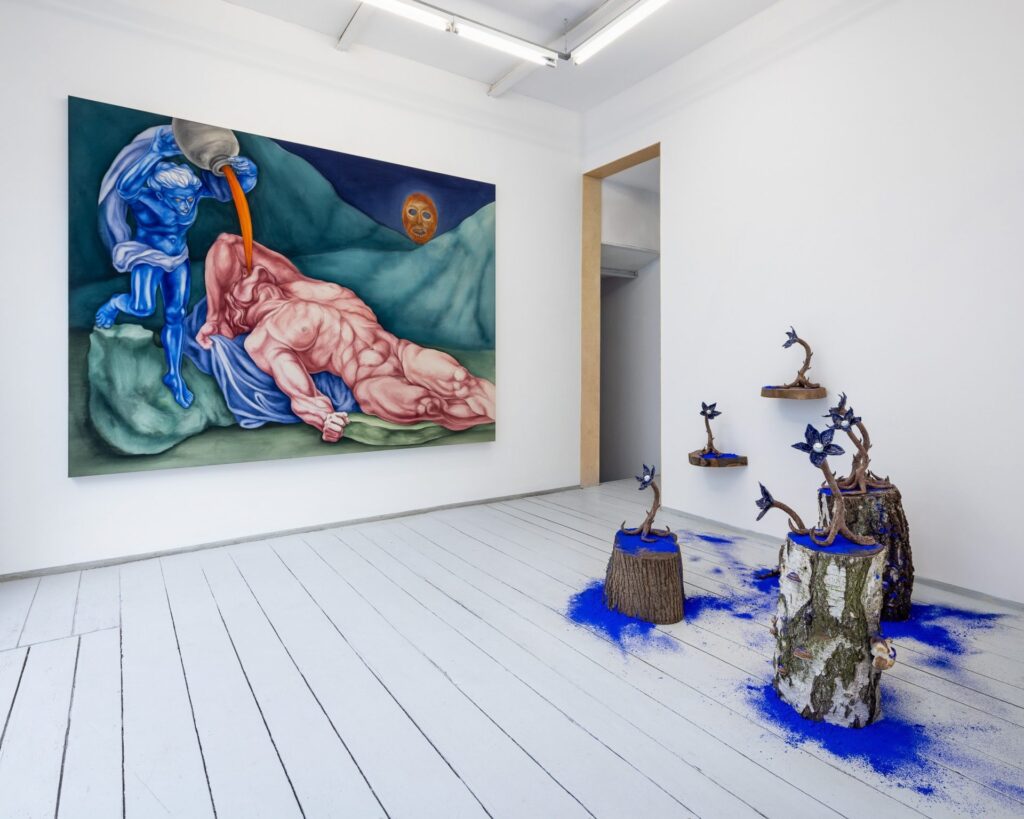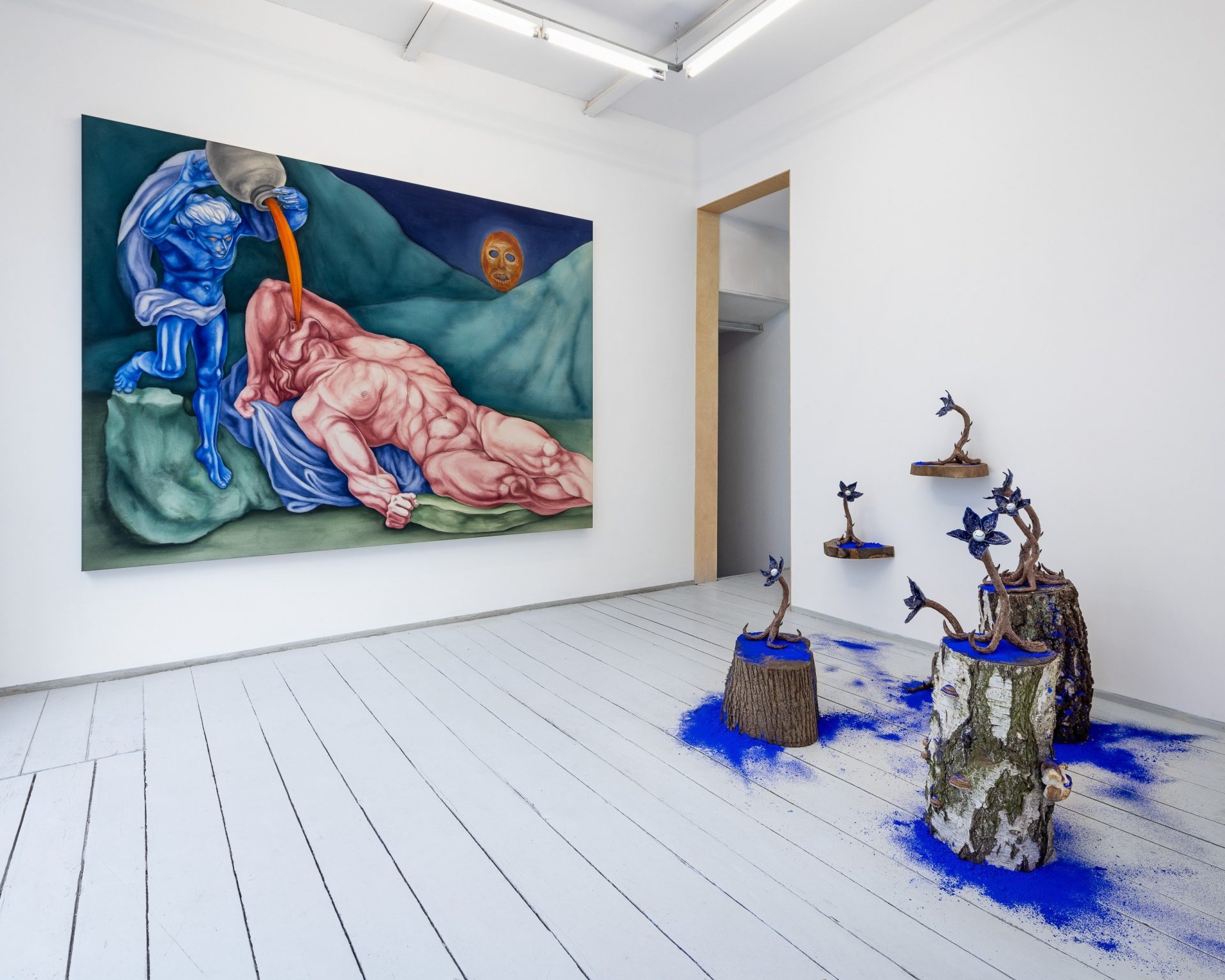Artists: Aleksandra Liput, Maciej Nowacki
Title: You have to be in hell to see heaven
Curator: Eleonora Bojanowska
Venue: Łęctwo gallery
Photos: Szymon Sokołowski

“One thing that comes out in myths is that at the bottom of the abyss comes the voice of salvation. The black moment is the moment when the real message of transformation is going to come. At the darkest moment comes the light.”
Joseph Campbell, The Power of Myth

In order to reach a universal truth of life one must first journey into one’s inner depths, in search of truth about oneself. Such travels benefit from having a guide – a teacher that will lead us and show the way in moments of doubt or when we stray off course. It is understood that this road is neither pleasant nor simple and it inevitably makes one face their own darkness. We will often stumble, even over “one’s own feet”, we will delude ourselves that we’ve already reached the goal while getting stuck in place. Nonetheless, ease, calm, attunement to the world and a sensation of being freed from surrounding matter await us at the end of this road. Myths of all cultures, holy books or traditions of shamanic ecstasies are tales of self-discovery, of reconnection with the spiritual world but also with the world at large understood as the cosmos, of one or many deaths in life. The exhibition “You have to be in hell to see heaven” presents Aleksandra Liput and Maciej Nowacki drawing on these tales to create their own story of a journey into the depths of one’s self. Maciej takes on the subject of the symbolic death of the body leading to growth, self-discovery and access to knowledge heretofore out of reach, as well as to freedom from prescribed socio-cultural norms. It also establishes a connection with nature. These practices recall shamanic rituals – in order to become a shaman one must go through a painful trial of mortifying the flesh. The goal of these practices was to uncouple oneself from identifying with what is material in order to establish a link with the immaterial, spiritual world. One of the steps meant to aid this process was the ingestion of various preparations of psilocybin mushrooms.







The symbolic death of the body, termed ego death by modern psychology, is a significant element of practically all religions and faiths in general. It explains the references to christianity and pagan beliefs in the artists’ works. The recurring blue hues, blue figures of a small boy and a mythological character are symbols of transformation (psilocybin mushrooms dye blue). In Siberia psilocybin is ingested with a shaman’s urine and in numerous places, Mexico among others, honey was used to preserve mushrooms containing psilocybin. That is why the eponymous character of the myth of Glaucus, which inspired Aleksandra, fell into a pot of honey where he was preserved up until his resurrection and the monk seen on Maciej’s “What is enlightenment” painting takes a blue boy’s urine into his mind. Terrence McKenna’s “Food of the Gods” features the author, in a sense, rewriting familiar myths by explaining supernatural occurrences with the heroes of these stories ingesting various psychoactive substances. By means of her ceramic works Aleksandra Liput retells the minoan “Myth of Glaucus”. It is a story of a boy that disappeared and was found by Polyidus in a pithos – a vessel filled with honey. The mage observes a snake using herbs to resurrect its companion, another snake, and uses this knowledge to resurrect Galucus. It is a tale of death leading to resurrection. The name Polyidus suggests a man-of-many-ideas – meaning a shaman, while Glaucus is someone blue-gray. Psilocybin mushrooms stain blue once broken up. Glaucus, a youngster preserved in a pithos full of honey, can make for a symbolic representation of the mushrooms themselves. This remarkable myth presents us with all the elements of a nearly forgotten cult of mushrooms: the question of death and resurrection, herb-savvy snakes and a gray-blue child preserved in honey. The works of both artists bring nature to life and depict it accompanying and supporting people in this journey. It cheers us on with a smile so that we are reborn as one with nature, one with the cosmos. While on this journey the forest gifts us a new face – a mask that remains in process, in between. It is up to us to give it its shape and final form. Only then, with its help, will we expand the limits of one’s existence. This forest mask is an external means to an internal transformation, an awakening in unity with oneself and with the world. It is something that you do not know well enough for now yet it kept you company since the very beginning.








The exhibition is a reflection on the contemporary search for the spiritual side of life as well as on what defines us as humans. Once again it becomes apparent that our desires and searches contain elements that remain unchanged regardless of the times, the culture or one’s philosophy or religion. For the artists, just like for the shaman, the world is more reminiscent of a tale than complex physical structures, which is why Aleksandra and Maciej tell us a story of living through death in life which leads to a heightening of our humanity, while moving us closer to the unknowable, to the transcendent world.
